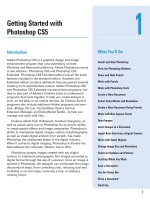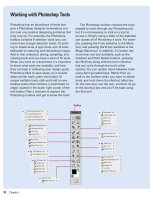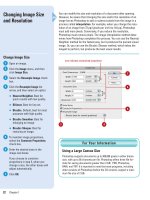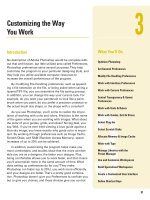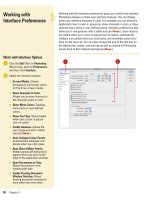Photoshop cs5 by steve Johnson part 3 pptx
Bạn đang xem bản rút gọn của tài liệu. Xem và tải ngay bản đầy đủ của tài liệu tại đây (632.72 KB, 6 trang )
ptg
16 Chapter 1
Photoshop lets you open image files created in different formats, such
as TIFF, JPEG, GIF, and PNG, as well as Photoshop documents in the
PSD or PSB (Large Document) formats. If you want to simply open an
image or Photoshop document, the Open dialog box is the most effi-
cient way. However, if you need to manage, organize, or process files,
Adobe Bridge or Mini Bridge (New!) is the way to go. You open an
existing Photoshop document or image file the same way you open
documents in other programs.
Opening Images
Open an Image
Click the File menu, and then click
Open to display all file types in the
file list of the Open dialog box.
TIMESAVER
Point to the Open
Recent command on the File menu
to quickly open a recent file.
Click the Files of Type (Win) or
Enable (Mac) list arrow, and then
select a format.
Click the the Look In (Win) or
Where (Mac) list arrow, and then
choose the location where the
image you want to open is stored.
Click the image file you want to
open.
TIMESAVER
Press and hold
the Shift key to select multiple
contiguous files to open in the
Open dialog box.
Click Open.
5
4
3
2
1
5
4
3
See Also
See “Understanding File Formats” on
page 391 for information on the differ-
ent file formats.
Opening a File as Another Format
The Open As command on the File menu allows you to open a file in
Photoshop that was saved incorrectly (with the wrong extension) or
is being moved between Windows and Macintosh systems. Click the
File menu, click Open As, select the file you want to open (if you do
not see the file you want, choose the option to display all files),
select the correct format from the Open As (Win) or Format (Mac)
list arrow, and then click Open. If the file does not open, then the
chosen format may not match the file's real format, or the file may be
damaged.
For Your Information
2
From the Library of Wow! eBook
ptg
Chapter 1 Getting Started with Photoshop CS5 17
You can use Photoshop's Place command to insert artwork into an
open document. To increase your control of the new image information,
Photoshop places the new image into a separate layer. Photoshop lets
you place files saved in PDF, Adobe Illustrator, and EPS formats. When
you first place a vector-based image into Photoshop, you have the abil-
ity to modify the width, height, and rotation while retaining the vector
format of the file. However, since Photoshop is primarily a raster pro-
gram, when you finalize your changes, Photoshop rasterizes the file
information (converts the vector data into pixels), and saves it as a
Smart Object, which means you can no longer edit the placed docu-
ment as you would a vector shape or path. However, you can still open
up the Smart Object in the original file, and make changes to update it.
Inserting Images in
a Document
Insert an Image in a Document
Using the Place Command
Open a Photoshop document.
Click the File menu, and then click
Place.
Select the document you want to
place into the active document.
Click Place.
Photoshop places the image in a
new layer, directly above the
active layer, and then encloses it
within a transformable bounding
box.
Control the shape by manipulating
the corner and side nodes of the
freeform bounding box.
Press Enter (Win) or Return (Mac)
to rasterize the image at the
resolution of the active document.
6
5
4
3
2
1
4
Freeform
bounding
box
3
5
New layer
placed
Did You Know?
You can scan images into Photoshop.
With the scanner hardware and soft-
ware connected and installed (includ-
ing the Twain plug-in), click the File
menu, point to Import, click Twain, set
scan settings, and then click Scan.
From the Library of Wow! eBook
ptg
18 Chapter 1
Raw image file formats are available with most mid- to high-end digital
cameras and contain information about how the image was taken. The
raw format turns off all camera adjustments, and saves the image infor-
mation to a digital memory card. When you open a raw file, Photoshop
opens Camera Raw, allowing you to adjust image details. If you're not
sure what to do, you can click Auto to have Camera Raw do it or drag
sliders to adjust options manually. You can adjust color tones, reduce
noise (New!), add grain (New!), add sharpening (New!), correct for
lens defects, add post-crop vignetting and effects (New!), and retouch
images with the Heal, Clone and Red Eye tools. Raw images are larger;
however, the increase in file size is actually more information that can
be used by Camera Raw. In addition, raw images can be converted into
16-bit mode, which provides more control over adjustments such as
tonal and color correction. Once processed, raw images can be saved
in the DNG (Digital Negative), TIFF, PSD, PSB, or JPEG formats. When a
raw file is placed as a Smart Object, Photoshop embeds the raw data
within the document, allowing you to change the raw settings and
update the converted layer.
Importing Raw Data
from a Digital Camera
Import a Camera Raw File
Click the File menu, and then click
Open.
◆ To pl ac e a raw file as a Smart
Object, click the File menu, and
then click Place.
Click the Files of Type (Win) or
Enable (Mac) list arrow, and then
click Camera Raw.
Select a single raw image file, or
Ctrl (Win) or A (Mac)+ click to
select more than one file.
Click Open.
The Camera Raw dialog box opens.
Click any of the tabs—Basic, Tone
Curve, Detail (Sharpen & Noise
Reduction), HSL / Grayscale, Split
Toning, Lens Correction, Effects
(New!), Camera Calibrations,
Presets, or Snapshots (New!)—to
change the options you want.
To au to mat ic all y make tonal
adjustments, click Auto on the
Basic tab, and then make any other
manual adjustments.
6
5
4
3
2
1
43
From the Library of Wow! eBook
ptg
Chapter 1 Getting Started with Photoshop CS5 19
Use the following tools to modify
the image:
◆ Use the Zoom, Hand, Rotate,
Crop, and Straighten tools to
change the size, orientation,
and position of the image.
◆ Use the White Balance tool to
set the image white balance or
the Color Sampler tool to
sample a color from the image.
◆ Use the Spot Removal or Red
Eye Removal tool to fix the
image.
◆ Use the Adjustment Brush or
Gradient Filter tool to make
adjustments to exposure,
brightness, contrast, saturation,
clarity, sharpness, and color.
There are two areas of the screen
related to image view:
◆ Image Preview. If checked,
displays current version of
image with all changes that
have been made.
◆ Zoom Level. Changes to the
level of image magnification
can be made here.
Click the filename to change the
(color) Space, (bit) Depth, Size,
and Resolution of the image.
Click Save Image(s) to specify a
folder destination, file name, and
format for the processed images.
Select the images you want to
synchronize (apply settings) in the
Filmstrip (if desired, click Select
All), and then click Synchronize.
Click the Camera Raw Menu
button to Load, Save, or Delete a
specific set of Raw settings.
When you’re done, click Done to
process the file, but not open
it, or click Open Image(s) to
process and open it in Photoshop.
Hold Alt (Win) or Option (Mac) to
use Open Copy or Reset.
13
12
11
10
9
8
7
Zoom level
Histogram
6
13
12
5
11
7
Image preview
9
10
Basic tab
Click to automatically
adjust tonal quality
Camera Raw Menu button
Drag sliders to make manual
adjustments
From the Library of Wow! eBook
ptg
20 Chapter 1
A Smart Object is a container in which you can embed raster (e.g.,
PSD, JPEG, TIFF) or vector (e.g., AI, PDF, EPS) image data from another
Photoshop or Adobe Illustrator file that retains all its original character-
istics and remains fully editable. A Smart Object can be scaled, rotated,
and warped nondestructively without losing original image data. Smart
Objects store source data with the original object, so you can work on
a representation of the image without changing the original—resulting
in one file embedded within another. For example, when an Illustrator
Smart Object is double-clicked in the Layers panel, Photoshop starts
Illustrator and opens a working copy of the artwork. When you make
changes in Illustrator and then save the file, Photoshop automatically
re-rasterizes the file. If you duplicate a Smart Object, Photoshop stores
only one copy of the source data while creating a second instance of
the composite data, thus saving valuable disk space. When you edit
one Smart Object, Photoshop updates all the copies. In addition, you
can link Smart Objects to their layer mask so they can be moved
together. You can create Smart Objects by converting selected layers,
pasting Illustrator data from the clipboard, using the Place command to
insert a file, or using the Open As Smart Object command.
Working with Smart
Objects
Work with Smart Objects
Use one of the following to create a
Smart Object:
◆ Click the File menu, click Open As
Smart Object, select a file, and
then click Open.
◆ Click the File menu, and then
click Place to import into an open
Photoshop document.
◆ Select a layer, click the Layer
menu, point to Smart Objects, and
then click Convert To Smart
Object.
If you use Place to import a Smart
Object, use the bounding box to
modify the image to the shape you
want.
Press Enter (Win) or Return (Mac) to
convert the image to a Smart Object
(in the Layers panel).
To ma ke a copy, drag the Smart
Object layer to the New Layer button.
Double-click the thumbnail of the
original or copy to open the editor for
the Smart Object.
5
4
3
2
1
1
4
Copy of Smart Object
Smart Object
From the Library of Wow! eBook
ptg
Chapter 1 Getting Started with Photoshop CS5 21
Make the desired changes to the
image, save, and then close the
editor window.
When you’re done working with a
Smart Object, use any of the
following:
◆ Convert to normal layer. Select
the layer, click the Layer menu,
point to Rasterize, and then
click Smart Object.
◆ Export contents. Select the
layer, click the Layer menu,
point to Smart Objects, and
then click Export Contents.
Photoshop saves the contents
in its original format, or PSB if it
was created from a layer.
◆ Replace contents. Select the
layer, click the Layer menu,
point to Smart Objects, click
Replace Contents, select a file,
and then click Open.
7
6
Changes made to one Smart
Object impacts all Smart
Objects.
7
Did You Know?
You can’t alter pixel data.
If you want
to use painting, dodging, burning, or
cloning tools, you need to convert the
Smart Object layer to a normal layer.
You can apply a filter to a Smart
Object.
When you apply a filter to a
Smart Object, the filter becomes a
Smart Filter. Smart Filters appear in the
Layers panel below the Smart Object
layer, where you can show or hide
them independently; they are nonde-
structive. You can apply any filter,
except Liquify and Vanishing Point.
You can convert a 3D layer to a Smart
Object (Extended).
Select the 3D layer
in the Layers panel, click the Options
menu, and then click Convert To Smart
Object. To re-edit the 3D content, dou-
ble-click the Smart Object layer.
Understanding Nondestructive Editing
In Photoshop, nondestructive editing allows you to make changes to
images while keeping the original image data intact. This flexibility
allows you to experiment with different effects without worrying
about harming your original image. You can perform nondestructive
editing in many different areas of Photoshop. These include: (1)
Transforming with Smart Objects, (2) Filtering with Smart Filters, (3)
Adjusting variations, shadows, and highlights with Smart Objects, (4)
Editing in Camera Raw, (5) Opening Camera Raw files as Smart
Objects, (6) Cropping nondestructively, (7) Masking with layers and
vectors, (8) Retouching on a separate layer using Clone Stamp,
Healing Brush, and Spot Healing Brush tools, and (9) Working with
adjustment layers.
For Your Information
From the Library of Wow! eBook
